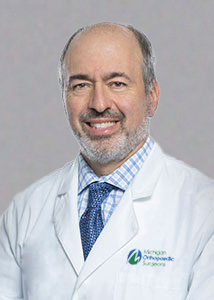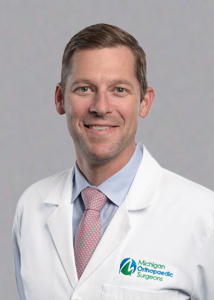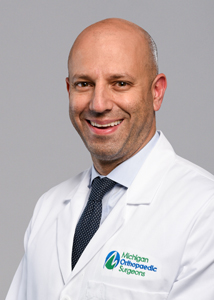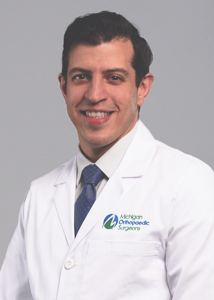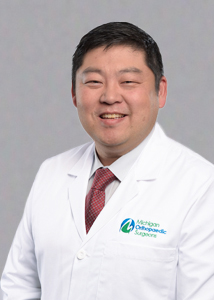Put back pain behind you.
Believe it or not, back pain is one of the most common reasons for a doctor’s visit. But with seven experts who specialize in it, we can get you back to normal in no time. The team at Michigan Orthopaedic Surgeons is the largest and most comprehensive in the state, so you can always expect orthopaedic excellence.
Conditions
CERVICAL HERNIATED DISC
CAUSE
A herniated disc is a common source of back and neck pain. Often referred to as a slipped or ruptured disc, this condition typically happens in the lower back, but can also occur in the smaller disc in the neck. A disc herniates or ruptures when part of the center nucleus pushes through the outer edge of the disc and back toward the spinal canal. As a result, this puts pressure on spinal nerves, which are very sensitive.
Conditions that can weaken your discs include:
- Improper lifting
- Smoking
- Excess weight that places additional stress on the disc in the lower back
- Sudden pressure
- Repetitive strenuous activities
SYMPTOMS
If your herniated disc is in your lower back, symptoms include:
- Back pain
- Weakness in the leg/foot
- A tingling feeling or numbness in the leg/foot
- Loss of bladder control
If your herniated disc is in your neck, symptoms include:
- Weakness and/or tingling in one arm
- Burning pain in the shoulders, neck or arm
TREATMENTS
Nonsurgical treatments are very effective. Most back and neck pain will reduce gradually with time. However, you can also try:
- Rest and over-the-counter pain relievers
- Gentle heat applications, after spasms
- Ice or cold compresses several times a day, for no more than 20 minutes each time
- Muscle relaxers, analgesics and anti-inflammatory medications
Surgical treatment is only recommended when nonsurgical treatment has not reduced your pain or other symptoms. Options include:
- Lumbar microdiscectomy: This is the most common surgical treatment for a herniated disc in the lower back. It involves removing both the herniated disc and any fragments that apply pressure on the spinal nerve.
- Cervical discectomy and fusion: Cervical discectomy is a procedure for pain and discomfort in the neck. To relieve pressure, the entire herniated disc is removed and replaced with bone and a metal plate to help support the spine.
Cervical SPONDYLOTIC MYELOPATHY
CAUSE
Cervical spondylotic myelopathy (CSM) is a condition that arises when the spinal cord becomes compressed or squeezed, due to the normal “wear-and-tear” and biological changes that occur in the spine as the body ages.
WHO’S LIKELY TO GET IT
The condition commonly occurs in patients over the age of 50.
SYMPTOMS
Normally, the symptoms of CSM develop slowly and progress steadily over time. However, in some cases, the condition may worsen more rapidly.
You may experience a combination of the following symptoms:
- Tingling or numbness in the arms, fingers or hands
- Weakness in the muscles of the arms, shoulders or hands
- Difficulty grasping or holding onto some items
- Imbalance and other coordination problems (With myelopathy, there is no sensation of spinning or “vertigo,” but rather, the body feels largely unstable.)
- Loss of fine motor skills, like writing, buttoning clothing, picking up coins or feeding oneself
- Pain or stiffness in the neck
TREATMENTS
For milder cases, nonsurgical treatment is used initially, with the goal of decreasing pain and improving the ability to perform common daily tasks and activities. Nonsurgical treatment options include:
- Soft cervical collar: This is a padded ring that wraps around the neck and is held in place with Velcro. The purpose of a soft cervical collar is to allow the muscles in the neck to rest while limiting the range of motion – decreasing the pinched nerve roots that accompany movement of the neck.
- Physical therapy: Specific exercises can help relieve pain, strengthen neck muscles and increase flexibility. Physical therapy can also help you maintain strength and endurance, making it easier to perform normal daily activities.
- Medications: In some cases, medications can help improve symptoms.
- Nonsteroidal anti-inflammatory medications: Drugs like aspirin, ibuprofen and naproxen can help relieve pain and reduce inflammation.
- Oral corticosteroids: A short course of oral corticosteroids may be used to help relieve or reduce pain and inflammation.
And although you may be inclined to try chiropractic manipulation for neck and back pain, manipulation should never be used for spinal cord compression.
If nonsurgical treatment does not relieve symptoms, there are several procedures that can be performed to help relieve pressure on the spinal cord. The procedure your doctor recommends will depend on many factors, including your symptoms, your age and the areas of spinal cord involvement.
SPINAL ARTHRITIS/STENOSIS
CAUSE
As we age, our spines change. And these normal “wear-and-tear” effects can lead to a narrowing of the spinal canal, called spinal stenosis.
WHO’S LIKELY TO GET IT
Children and young adults have discs with high water content. As we get older, the discs begin to dry out and weaken, causing a problem known as settling, or collapse of the disc space and loss of disc space height. Arthritis is the most common cause of spinal stenosis, as a result of the disc degeneration and loss of water content. Thus, spinal stenosis most often occurs in adults ages 60 and older. (It is equally common in men and women.)
SYMPTOMS
Symptoms of spinal stenosis include:
- Back pain: People with spinal stenosis may or may not have back pain. The degree of arthritic development dictates the pain, or lack thereof.
- Burning pain in buttocks or legs: Pressure on the spinal nerves can result in pain in the areas that the nerves supply. The pain may be described as an ache or a burning feeling. It typically starts in the area of the buttocks and radiates down the leg. As it progresses, it can result in pain in the foot.
- Numbness or tingling in buttocks or legs: As pressure on the nerve increases, numbness and tingling often accompany the burning pain. (Not all people have both burning pain and numbness/ tingling.)
- Weakness in the legs or “foot drop:” Once the pressure reaches a critical level, weakness can occur in one or both legs. Some will suffer from what is referred to as “foot-drop,” or the feeling that the foot is slapping on the ground while walking.
- Less pain leaning forward or sitting: Studies of the lumbar spine show that leaning forward can increase the available nerve space. Some find relief riding a stationary bike or walk more comfortably by leaning on a shopping cart. (However, walking more than a short distance may bring on severe sciatica, discomfort and weakness.)
TREATMENTS
Nonsurgical treatment focuses on restoring function to the extremities and pain relief. And although nonsurgical methods do not improve the narrowing of the spinal canal, many people report they help to alleviate their symptoms. Options include:
- Physical therapy: Stretching exercises, massage, as well as lumbar and abdominal strengthening are used to help manage the noted symptoms.
- Anti-inflammatory medications: Because stenosis pain is caused by pressure on a spinal nerve, reducing inflammation around it may relieve pain. When used over the course of five to 10 days, these medications can also have an anti-inflammatory effect.
- Steroid injections: Cortisone is a powerful anti-inflammatory drug. Injections around the nerves or in the “epidural space” can decrease swelling, as well as pain. They can also reduce numbness, but not weakness, in the legs and lower extremities. (You should receive no more than three injections in the course of a year.)
- Acupuncture: Acupuncture can be helpful in treating some of the pain for less severe cases of lumbar stenosis. Although it can be very safely administered, long-term efficacy of this treatment has not been proven scientifically.
- Chiropractic manipulation: Chiropractic manipulation, administered by a professional, is generally considered safe and may help to alleviate some pain associated with lumbar stenosis.
Surgery for spinal stenosis is generally reserved for people who experience poor or reduced quality of life due to enduring pain and general weakness. In these cases, there are two main surgical options to treat lumbar spinal stenosis: laminectomy and spinal fusion. Both may result in long-term pain relief, but it’s important to discuss both procedures with your doctor.
- Laminectomy: This procedure involves removing the bone, bone spurs and ligaments that are compressing the nerves. It’s commonly referred to as “decompression.”
- Spinal fusion: If arthritis has progressed to spinal instability, a combination of decompression and stabilization or spinal fusion may be recommended.
RADICULOPATHY/ARM PAIN
CAUSE
Cervical radiculopathy is commonly referred to as a “pinched nerve.” It occurs when a nerve in the neck is compressed or irritated where it branches away from the spinal cord. Typically, it’s the result of degenerative changes that occur in the spine as the body naturally ages, or it’s from an injury that causes a herniated disc or bulging of the intervertebral disc.
SYMPTOMS
Normally, the pain of cervical radiculopathy starts at the neck, radiates into the shoulder and travels down the arm, in the area served by the damaged nerve. It’s often described as a burning sensation. Certain movements, such as extending or straining the neck or turning the head, may increase the pain. Other symptoms include:
- Tingling, or the feeling of “pins and needles” in the fingers or in the hand(s)
- Weakness in the muscles of the arm, shoulder or hand
- Loss of sensation
Some people report that pain decreases when they place their hands on top of their head. This movement may temporarily relieve pressure on the nerve root.
TREATMENTS
The majority of people with cervical radiculopathy recover over time and without treatment. For some, the pain goes away relatively quickly. For others, it may take days or even weeks. It’s also common for cervical radiculopathy that has improved to return in the future. When this occurs, it frequently improves without treatment.
However, there are cases where cervical radiculopathy does not improve. In such cases, you’ll require evaluation and a treatment protocol defined by a physician. The initial treatment for cervical radiculopathy is nonsurgical. Options include:
- Soft cervical collar: This is a padded ring that wraps around the neck and is held in place with Velcro. The purpose of a soft cervical collar is to allow the muscles in the neck to rest while limiting the range of motion – decreasing the pinched nerve roots that accompany movement of the neck.
- Physical therapy: Specific exercises can help relieve pain, strengthen neck muscles and improve range of motion. In some cases, traction can be used to gently stretch the joints and muscles of the neck.
- Medications: Aspirin, ibuprofen and naproxen may provide relief if your pain is caused by nerve irritation or inflammation.
If nonsurgical treatment does not relieve symptoms, your doctor may recommend surgery. The procedure they recommend will depend on many factors, including the symptoms as well as the location of the nerve root.
Scoliosis/Spinal Deformity
Cause
Commonly seen in children and adolescents, scoliosis is a sideways curvature in the spine, and there are several different types of it:
- Idiopathic scoliosis: The term “idiopathic” means unknown cause. While the medical community does not know for sure what causes most scoliosis cases (80 to 85% of them), it is known that it tends to run in families. Scoliosis is not a disease you can catch from someone else, and there is nothing you can do to prevent it. Idiopathic scoliosis can occur in toddlers and young children, but most cases occur from age 10 to the time a child is fully grown.
- Congenital scoliosis: The term “congenital” means you’re born with the condition. Congenital scoliosis starts as the spine forms before birth. Part of one vertebra (or more) does not form completely, or the vertebrae do not separate properly. Some types of congenital scoliosis can change quickly with growth, while others can remain unchanged. This type of scoliosis can also be associated with other health issues, including both heart and kidney problems.
- Neuromuscular scoliosis: Any medical condition that affects the nerves and muscles can lead to scoliosis. This is most commonly due to muscle imbalance and/or weakness. Common neuromuscular conditions that can lead to scoliosis include cerebral palsy, muscular dystrophy and spinal cord injury.
Symptoms
Scoliosis is not often painful. So, if it’s not diagnosed at birth, it can go undetected. A child may suspect something is wrong if clothes don’t seem to fit properly. Additionally, parents often discover the problem in early summer, when they see children in a bathing suit.
While symptoms vary by the type of scoliosis, the physical signs of scoliosis include:
- Tilted, uneven shoulders, with one shoulder blade protruding more than the other
- Prominence of the ribs on one side
- Uneven waistline
- One hip higher than the other
- Overall appearance of leaning to the side
In rare cases, there may be a problem with the spinal cord or nerves that produces weakness, numbness or a loss of coordination.
Treatments
Treatment for scoliosis may take several forms, depending on the age of the patient, the type of scoliosis and the tendency of the curve to worsen.
There are three proven treatments for scoliosis: observation, bracing and surgery. A doctor will recommend a course of treatment based on the severity of the scoliosis, the symptoms and the physical maturity of the child. (These features predict how the scoliosis is likely to behave during the growth years and as an adult.)
Most scoliosis surgeons agree that children who are afflicted with severe curves (45 to 50° and higher) require surgery to lessen the curve and prevent it from worsening. That operation is a spinal fusion, which realigns and fuses the curved vertebrae so they heal into a single, solid bone. This stops growth completely in the abnormal segment of the spine.
Spinal Trauma Fractures
Cause
Most spinal fractures occur in the thoracic (mid-back) and lumbar spine (lower back), or at the connection of the two (thoracolumbar junction), and they can vary in severity. While some fractures are very serious and may require emergency treatment, other fractures can be the result of bones weakened by osteoporosis. Fractures of the thoracic and lumbar spine may result from high-energy trauma, such as a:
- Car or motorcycle accident
- Fall from height
- Sports accident
- Violent trauma (such as a gunshot wound)
Types
The three major types of spine fracture patterns are:
- Flexion
- Compression fracture: While the front (anterior) of the vertebra breaks and loses height, the back (posterior) portion does not.
- Axial burst fracture: In this type of fracture, the vertebra loses height on both the front and back portions. It is often caused by landing on the feet after falling from a significant height.
- Extension
- Flexion/distraction (chance) fracture: The vertebra is literally pulled apart (distraction). This type of fracture can occur in a head-on car collision, when the upper body is thrown forward while the pelvis is stabilized by a lap seat belt.
- Rotation
- Transverse process fracture: This uncommon fracture results from rotation or extreme sideways (lateral) bending.
- Fracture-dislocation: This is an unstable injury involving bone and/or soft tissue, in which a vertebra moves off an adjacent vertebra (displacement).
Symptoms
A fracture of the thoracic or lumbar spine causes moderate to severe back pain that is worsened with movement. If the spinal cord is involved, there may be bowel and/or bladder dysfunction along with numbness, tingling and weakness in the limbs. If the fracture is caused by high-energy trauma, there may also be a loss of consciousness (a “black out”) or a brain injury. If there are other associated injuries, called distracting injuries, causing pain that overwhelms the back, it has to be assumed that the spine has been fractured, especially after a high-energy event or a motor vehicle crash.
Treatments
Treatment depends on the severity of the fracture and whether there are other associated injuries. Once the trauma team has stabilized all other life-threatening injuries, the doctor will evaluate the spinal fracture pattern and decide whether spine surgery is needed.
Treatments
Experts at Michigan Orthopaedic Surgeons offer the following treatment options:
- Anterior Cervical Discectomy and Fusion
- Artificial Cervical Disc Replacement
- Cervical Epidural Injections
- Cervical Facet Injections
- Cervical Lamino-Foraminotomy
- Discogram
- Electromyography (EMG)
- Lumbar Epidural Injections
- Lumbar Fusion
- Lumbar Laminectomy
- Lumbar Microdiscectomy
- Microsurgical Cervical Laminoplasty
- Radiofrequency Neurotomy/Rhizotomy
- Sacroiliac Injections
- Thoracic Epidural Injections
- Thoracic Facet Injections
Doctors
